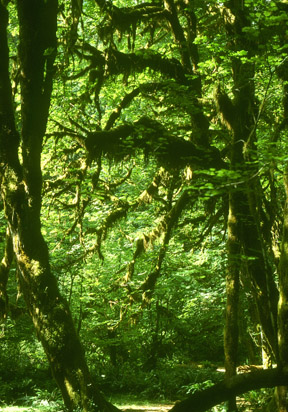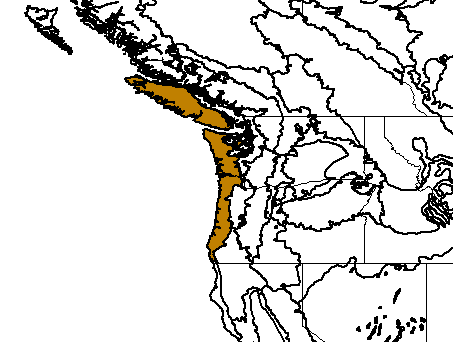
Hall of Mosses, Hoh rain forest, Olympic Ntl. Park, Washington (c) 2005 James H. Bassett
Bioimages home (click on an image to enlarge)
view
this page in its intended navigation context
Central Pacific Coastal Forests
(WWF
ecoregion
NA0510)

Hall of Mosses, Hoh rain forest, Olympic Ntl. Park, Washington
(c)
2005 James H.
Bassett

Source of bioregions data:
Olson, D. M. and
E. Dinerstein. The Global 200: Priority ecoregions for global conservation. (PDF
file) Annals of the Missouri Botanical Garden 89:125-126.
Distinctiveness (1=highest,4=lowest): 1
(globally outstanding)
Among the richest North American temperate coniferous forests for amphibians and
birds.*
Conservation Status (1=most endangered, 5=most
intact): 2 (endangered)
About 4% intact habitat in small, fragmented blocks. Threatened by
logging, agriculture, and development.*
 | Pseudotsuga menziesii | (Douglas fir) |
 | Tsuga heterophylla | (western hemlock) |
 | Thuja plicata | (western red cedar) |
 | Abies grandis | (grand fir) |
 | Picea sitchensis | (Sitka spruce) |
 | Pinus monticola | (western white pine) |
 | Quercus garryana | (Oregon white oak) |
 | Cornus nuttallii | (Pacific dogwood) |
 | Arbutus menziesii | (Pacific madrone) |
 | Tsuga mertensiana | (mountain hemlock) |
 | Chamaecyparis nootkatensis | (Alaska cedar) |
 | Pinus contorta | (lodgepole pine) |
Associated habitats
Temperate rain forest, Hoh valley, Olympic National Park, Washington


left: hillside, right: moss on branches
(c) 2005 Steven J. Baskauf
hires
hires



left: beginning nurse log, center: mature nurse log, right:
sword ferns
(c)
2005 James H.
Bassett
hires, (c) 2004
Maurice J. Kaufmann
hires hires


left: salmon spawning stream, right: stream bed with small salmon
(c) 2005 Steven J. Baskauf
hires
hires
Riparian forest, Hoh River, Olympic National Park, Washington



(c) 2005 Steven J.
Baskauf
hires
hires
hires
Lakes and adjacent forests, Lakes Crescent and Quinault, Olympic National Park, Washington




left two images: Lake Crescent, right two images: Lake Quinault
(c) 2005 Steven J.
Baskauf
hires
hires
hires
hires
Sitka spruce coastal forest, Olympic National Park, Washington




Picea sitchensis (Sitka spruce)
is
one of the few trees that can tolerate the salt spray present in the fog along
the coast.
(c) 2005 Steven J.
Baskauf
hires
hires
hires
hires
Tree farm, Olympic Peninsula, Washington




Most of the west and northwest side of the Olympic Peninsula outside Olympic
National Park consists of tree farms. Far left: These "plantations"
contain one (Pseudotsuga menziesii, Douglas
fir) or few species of fast-growing conifers. They are scheduled to
be clearcut on an approximately 50 year rotation (left center) Right
center: Recent clearcut with scattered "seed trees" left standing to reseed the
area. Far right: This management practice results in large areas of
single-species, uniform-aged stands -- biological deserts in comparison to the
old-growth forests of the park.
(c) 2005 Steven J.
Baskauf
hires
hires
hires
hires
* Ricketts, T.H., E. Dinerstein, D.M. Olson, C.J. Loucks, et al. (1999) Terrestrial Ecoregions of North America: A Conservation Assessment. World Wildlife Fund - United States and Canada. Island Press, Washington, D.C. pp. 222-224.
Except as noted, images copyright 2002-2005 Steve Baskauf - Terms of use